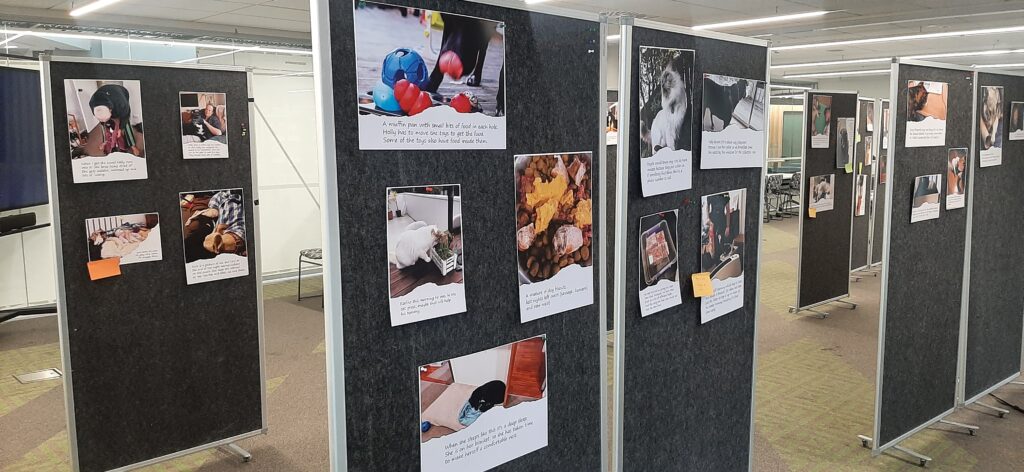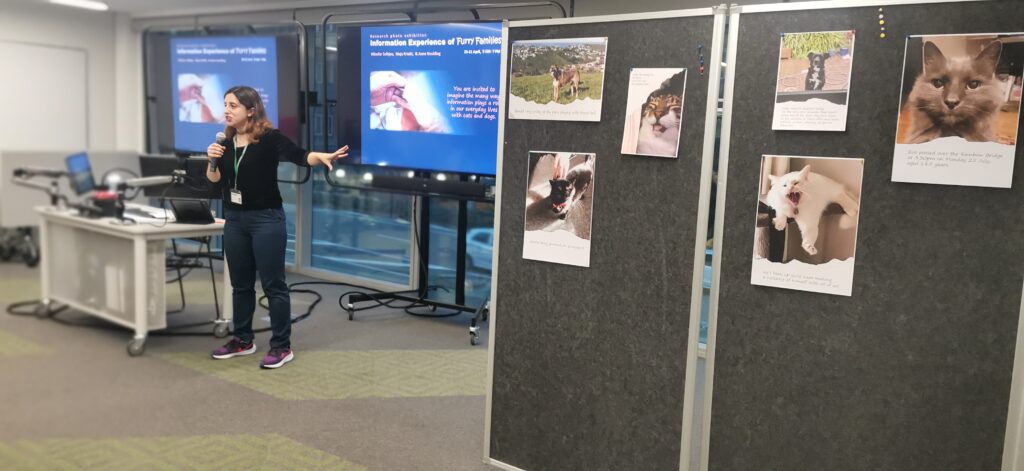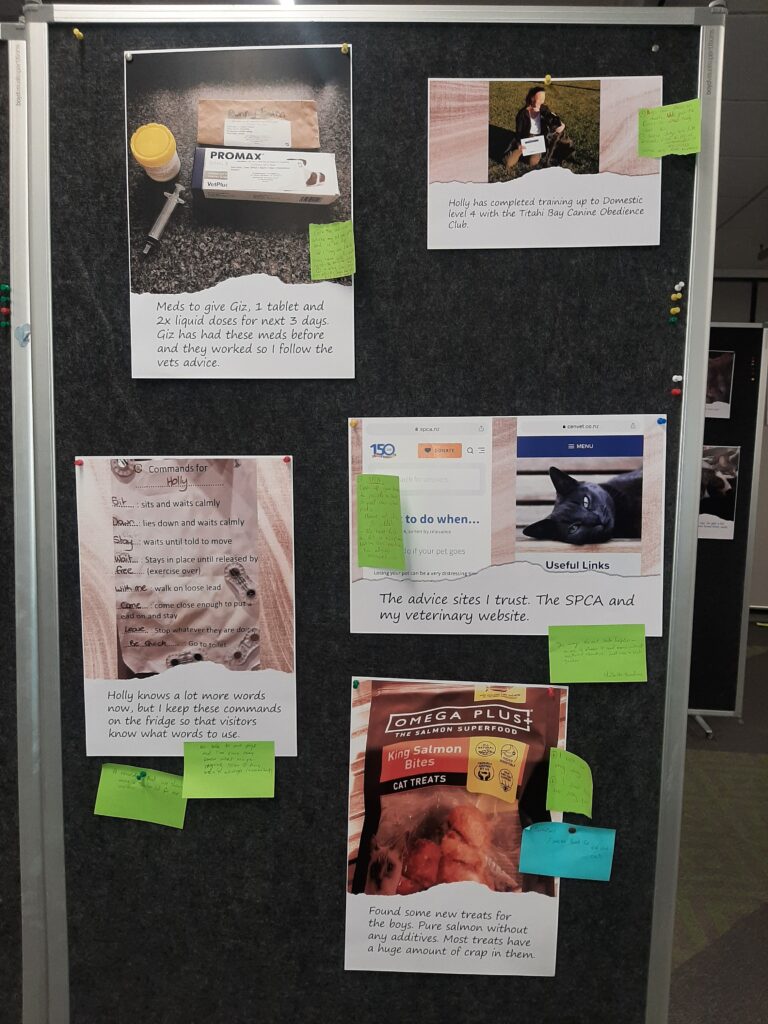The Photo Exhibition: A visual exploration of information in our shared lives with companion animals
The Photo Exhibition: A Visual Exploration of Information in Our Shared Lives with Companion Animals
Niloofar Sohjoo

About the Exhibition
The Information Experience of Furry Families exhibition was held at the Victoria University of Wellington (VUW), New Zealand, on April 20-21, 2023. The exhibition featured a series of photographs and photo voices made by animal guardians across New Zealand to highlight the information that shapes understanding between the dog, cat, and their humans.
—Using visual art as a mode of representing research findings is not common in Information Science but there are few examples in the field (see Hartel's (2014) collection of iSqures, and Gorichanaz's (2018) art exhibition reported in Downey (2018)).—
This exhibition was part of a larger PhD project by the author, at the School of Information Management. The research project aimed to explore the information experience within multispecies families (Solhjoo, Krtalić, Goulding, 2022). In such a family, human and non-human members share daily activities, places, and mutual experiences (Fox, 2006; Haraway, 2008). Niloofar has applied creative methods to encourage empathy toward other living beings and consider animals as an actor in information behavior research. A digital storytelling web-app called PixStori was used among participated families to share their daily photo diaries about what they found informative in living with their companion cat/dog. While the photographs were taken and interpreted by the human, the animal role in shaping information within things and practices were prioritized in all photographs (Solhjoo, Goulding, Krtalić, 2022).
—Influenced by the red thread of information that goes through all animal lives (Bates 1999, Bates 2022) the exhibition aimed to represent a rich understanding of how meanings are made or how things are done in a multispecies family.—
The Format of the Exhibition
The exhibition presented a part of the research findings in a visual format. The art instalments in the entire room were in the form of printed photographs with written captions, or a set of images with audio description. They were grouped into twenty-five collections of different emotional, embodied, and intersubjective facets of the interactions between humans, animals, and information. The exhibition visually represented information in a variety of forms, from a collar worn by a cat, a list of dog commands stuck on a fridge door, to cat fur, dog poop, and animal breed, to a dog staring at the door, and the communicative touch between a human and his cat. There was a map to guide the visitors about the list of collections and their representing concepts.

The exhibition was well attended, with visitors from the students at VUW, GLAMR sectors, and the public. The photographs generated some discussion among visitors. Many visitors commented on how they were able to relate to the experiences depicted in the collections. The exhibition was designed in an interactive format to co-contribute to the holistic view of information, and to gain insights into how information within these visual materials were experienced and expressed by the viewers. Sticky notes were used by the audiences to add their viewpoints about what they saw as information in each piece or collection. This activity continued in an open-ended nonprescriptive way and contributed to the development of the collections.

The Outcome of the Exhibition
A quick walk in this exhibition could easily demonstrate a holistic view of different phenomena that are experienced as information in the multispecies home. This form of visual representation communicates information easier than conventional mode of verbal representation, specially when other (nonhuman) animals are important within the research. The presented visual stories revealed at least as much about the information in a life of a person who took it as it does about the animals who are figured in it.
It also provided a powerful way of connecting with audiences. There were four sites of perspective within the items in this exhibition (as recognized by Rose’s (2007) critical visual methodology). The perspective of the photo creators (research participants) who visually describe excerpts of their daily life with dog and cat. Second, the image itself that shows the animals who has given a voice (or at least physically presented in the image). Third, the perspective made by the researcher to re-tell (represent) the visual stories in a specific way to show different concepts. Finally, the perspective of the audiences who built personal connections with these visual stories and were added with sticky notes.
Apart from bringing holistic approach and multiple perspectives in understanding information, using visual or artistic method for research representation improved empathy and closeness to others. These collections reminded the love and the fun that companion animals bring into our lives.
—The exhibition attracts empathy toward animals in everyday information behavior research by presenting information as a subjective concept in more-than-human habitation.—
Final Note
This collection aim to continue to be presented in different international academic meetings as a mode of visual representations of information within the multispecies daily life.
References
Bates, M. (1999). The invisible substrate of information science. Journal of the American Society for Information Science, 50(12), 1043–1050.
Bates, M. (2022). A proto-paradigm for information science research. In Proceedings of CoLIS, the 11th. International Conference on Conceptions of Library and Information Science, Oslo, Norway, May 29 – June 1, 2022. Information Research, 27(Special issue), paper colis2201.
Downey, B. A. (2018, April 11). New Rincliffe Gallery exhibition demonstrates the artistic process. Drexel Now. Retrieved from http://drexel.edu/now/archive/2018/ April/New_Rincliffe_Gallery_Exhibition_Demonstrates_Artistic_Process/
Fox, R. (2006). Animal behaviours, post-human lives: Everyday negotiations of the animal–human divide in pet-keeping. Social & Cultural Geography, 7(4), 525-537.
Haraway, D. J. (2008). When species meet. University of Minnesota Press.
Hartel, J. (2014). An arts-informed study of information using the draw-and-write technique. Journal of the American Society for Information Science and Technology, 65(7), 1349–1367.
Rose, M. (2007). Visual methodologies: An introduction to the interpretation of visual images. London: Sage.
Solhjoo, N., Goulding, A., & Krtalić, M. (2022). Companion animal representation and voice in information behavior research. Library & information science research, 44(4), 101198. doi:10.1016/j.lisr.2022.101198
Solhjoo, N., Krtalić, M. and Goulding, A. (2022). Pets and people: information experiences in multispecies families. Journal of Documentation, 78 (5), 1092-1108.
Cite this article in APA as: Sohjoo, N. (2023, April 26). The photo exhibition: A visual exploration of information in our shared lives with companion animals. Information Matters, Vol. 3, Issue 4. https://informationmatters.org/2023/04/the-photo-exhibition-a-visual-exploration-of-information-in-our-shared-lives-with-companion-animals/






